The STAMPED method provides a quick way to start outlining specifications for vacuum jacketed hoses (and is widely used across hose and insulated hose industries in general). STAMPED is an acronym that stands for Size, Temperature, Application, Materials, Pressure, End fittings, and Delivery.
Size
Size requirements include diameter, length, and overall thickness. When specifying sizes, it’s helpful to include a drawing, if you have one.
Inner Diameter (ID)
Vacuum jacketed hoses are double-walled, which means that they are comprised of an inner and an outer hose. They are measured according to their “inner diameter” or “ID.” The ID of a vacuum jacketed hose refers to the nominal pipe size of the inner hose. The inner diameter has important implications for your system setup; for example, the inner diameter must be able to accommodate the flow rate.
Outer Diameter (OD)
If your system is space-constrained, is there a maximum width or outer diameter that the insulated hose assembly must fit into? In vacuum jacketed hose assemblies, the distance from the inner wall of the inner tube to the outer wall of the outer tube is referred to as the “overall wall thickness.” In other insulated tubing assemblies, the overall thickness refers to the distance from the inner wall of the inner tube to the outer surface of the insulation material.
Most vacuum jacketed hose suppliers carry a similar range of inner diameter sizes. But, the outer diameter can vary greatly according to that brand’s specific design. Some suppliers carry thinner hoses than others. Compare the outer diameter of various hose suppliers to see which one would be best for your system.
Length
What is the total length that the hose needs to cover? Do you require one continuous hose, or would you prefer to join together multiple hoses in succession?
Temperature
What is the target temperature of the media being transferred through the hose? What is the ambient temperature surrounding the hose? Is the temperature constant, or are there spikes and drops?
For insulated hoses, specify the level of thermal performance needed for your application. One way to describe insulation performance is with R-values. Another way to indicate insulation performance is by describing the temperature difference between the internal media and the external surface of the hose assembly. Temperature difference is also written as ΔT, pronounced “delta T.”
Application
In what application will this hose be used? How will it be configured or routed (hanging, supported, unsupported, etc.)? Will it be in a stationary position, or is motion required? If the hose is stationary, this is referred to as a “static” application. If the hose is in motion, it is referred to as a “dynamic” application.
Will the hose be used intermittently for short periods of time? Or, will fluid be continuously transferred through the hose for extended periods of time? Understanding the duration and frequency of use is important for determining the level of insulation performance required.
Consider other challenges presented by the application. Are the inner or outer surfaces exposed to materials that could cause damage to the hose or insulation materials? Are abrasive materials, oils, solvents, acids, ozone, or salt water present? Does this application typically face issues with corrosion under insulation (CUI)?
Materials
What substances will be conveyed through the hose? What types of materials are they compatible with? What type of environment will be surrounding the hose assembly? Note if flame resistance or flammability will be an issue. Are there specific material codes or standards (FDA, API, etc.) that need to be met?
For insulated hoses, you may need to specify certain materials that are or are not suitable for your application. For example, some systems cannot use fibrous insulation due to shedding. Does the insulated hose need to fulfill food-grade, medical-grade, or cleanroom material requirements?
Pressure
For most applications, pressure specifications refer to internal pressure (the pressure of the fluid inside the hose). These specifications can include operating or working pressure, maximum pressure, and burst pressure.
In some highly specialized applications, there may be external pressure specifications as well. The vast majority of applications are at atmospheric external pressure (1 psi).
End Fittings
What type of end fittings are used to connect the hose to the fluid source? Do the end configurations need to meet specific material, dimensional, or conductivity requirements?
Delivery
Specify packaging, and delivery requirements. How many hoses do you need, and when do you need them by? Are there special testing requirements? Do the hoses need to meet certain cleanliness levels such as oxygen cleanliness? Be sure to communicate all of these important elements to your vacuum jacketed hose supplier.
Have questions? We’re here to help. Contact us →


